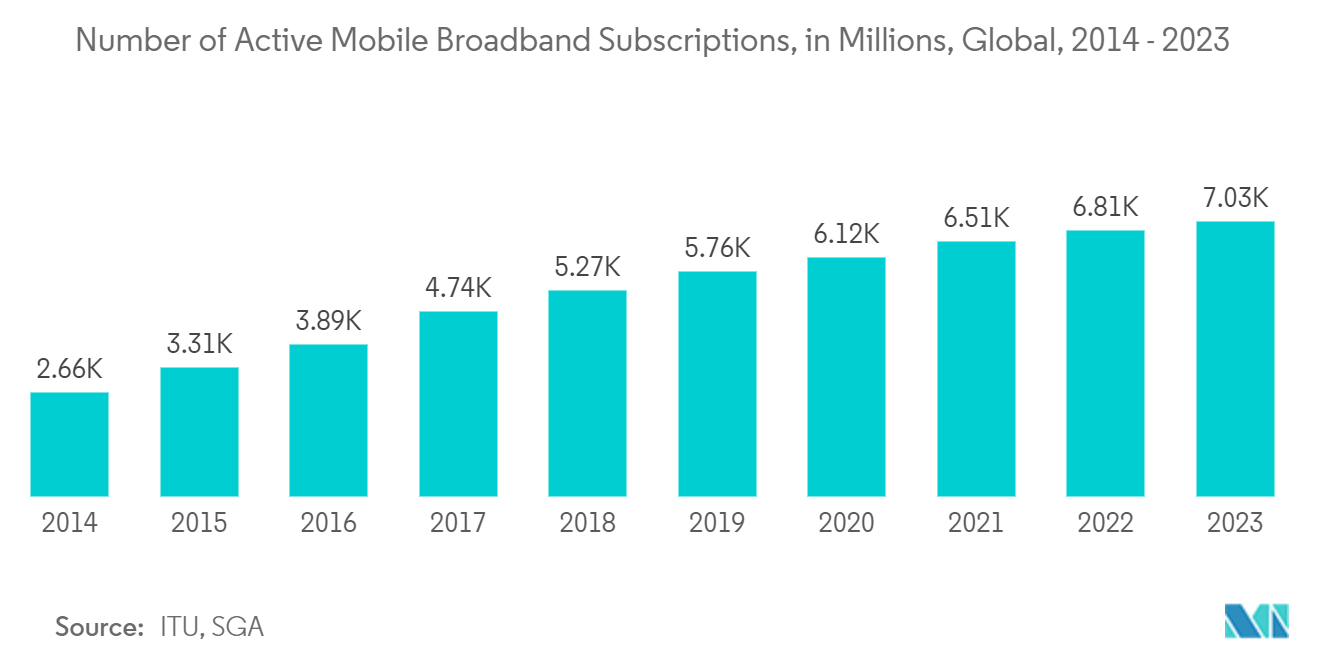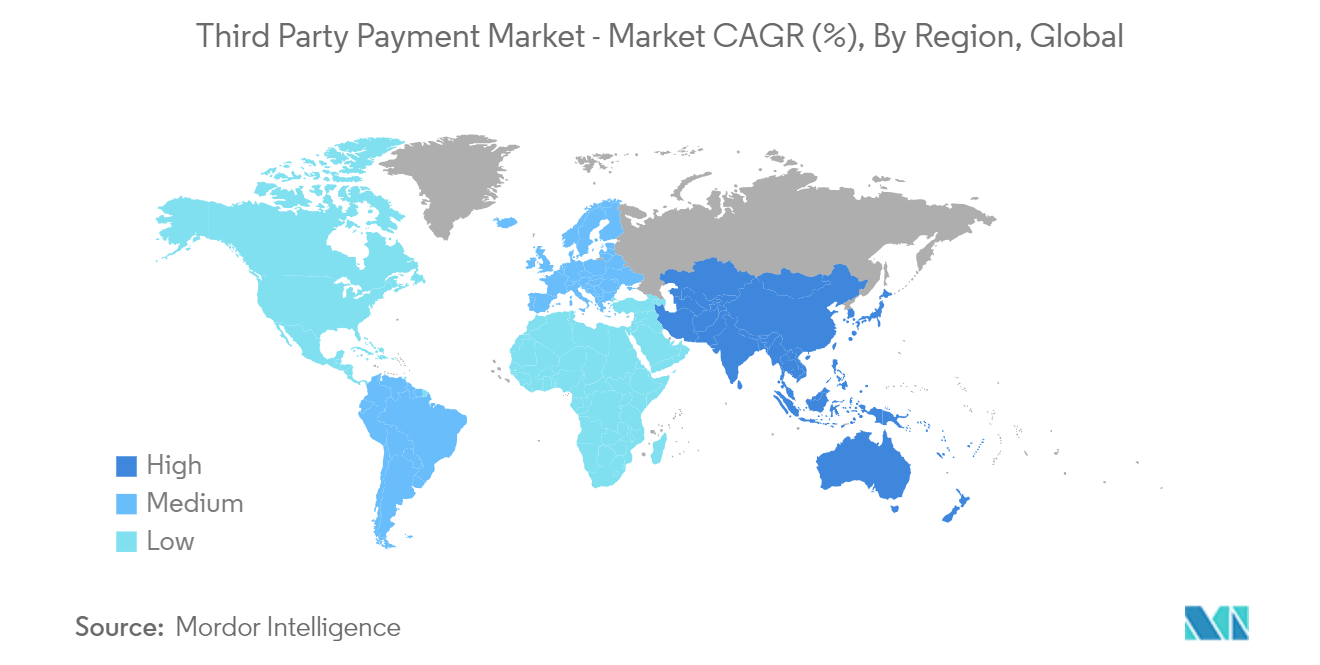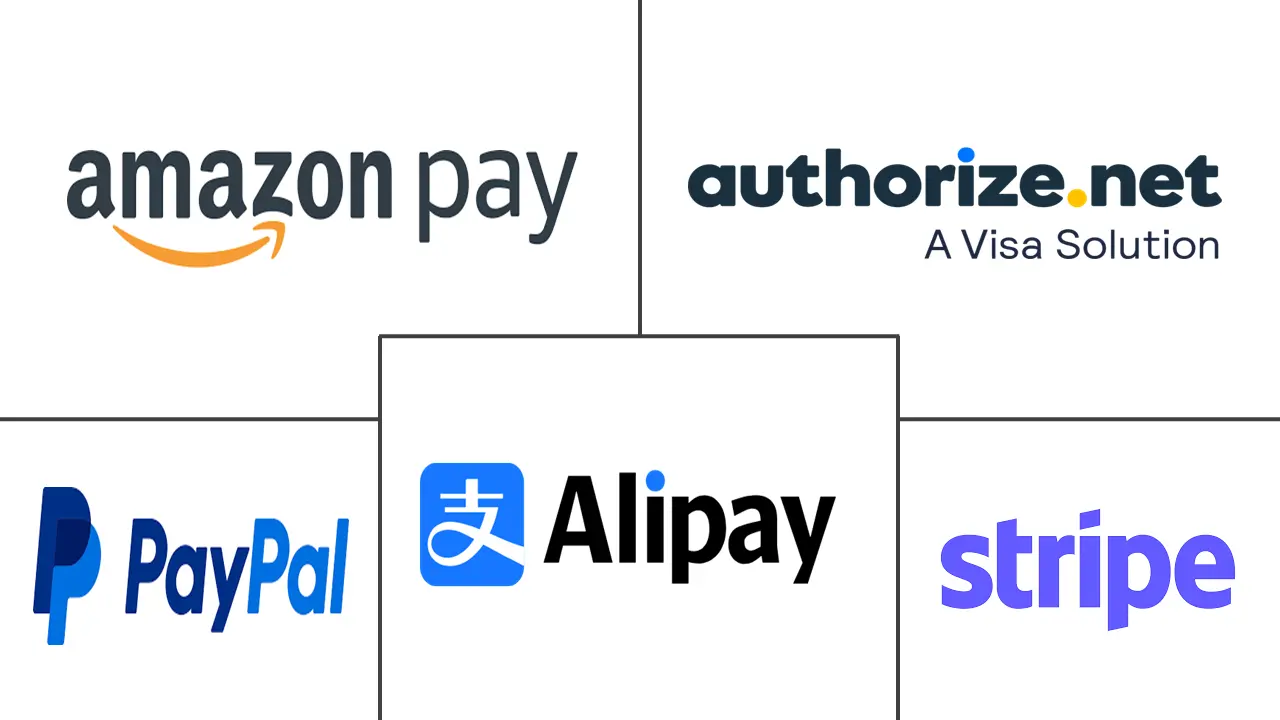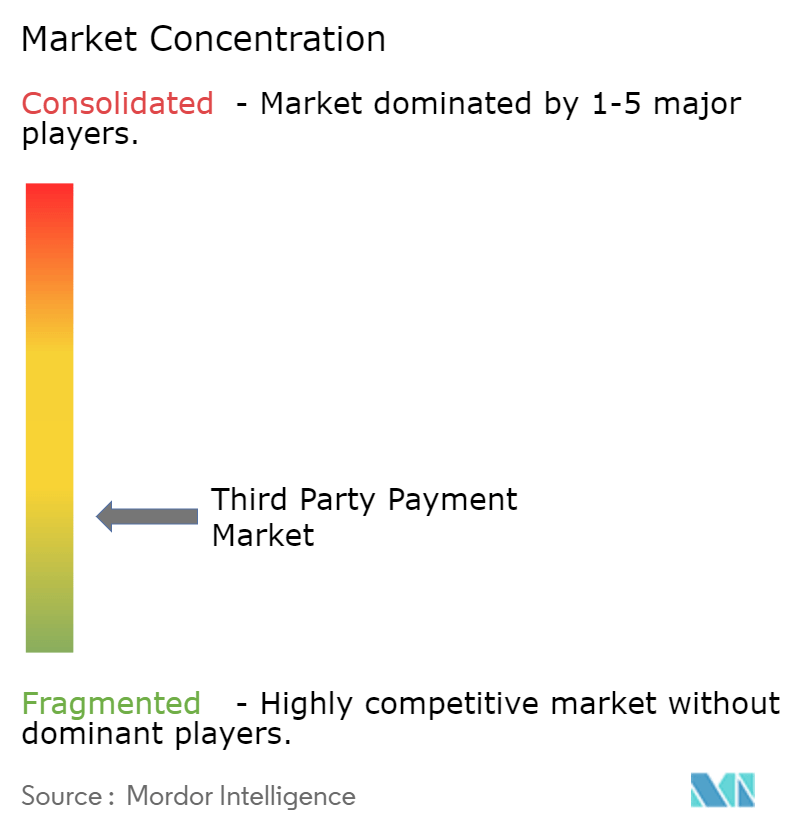
Third Party Payment Market Analysis
The Third Party Payment Market size is estimated at USD 71.80 billion in 2025, and is expected to reach USD 143.10 billion by 2030, at a CAGR of 14.79% during the forecast period (2025-2030).
Third-party payment includes payment processors and payment aggregators or credit card processing companies, enabling merchants to accept credit card payments, online transactions, and other cashless methods without requiring their merchant accounts. These third-party payment solution providers, including PayPal, Stripe, and others, can simplify business operations for merchants, ensuring easy payment flows and transactions and supporting the market demand for third-party payment solutions.
- E-commerce business solutions are evolving to perform cross-border transactions and international payments. Online shopping platforms leverage seamless API integration, ensuring businesses and customers a secure and efficient purchasing experience. Payment gateway services and plugins are available directly from banks and various providers. This shows the demand for the studied market due to their applications in the e-commerce sector.
- As internet access becomes more widespread, individuals and businesses turn to digital channels for their financial transactions. This trend has created a beneficial environment for the growth of third-party payment providers offering convenient and secure online payment solutions.
- Technology providers' introduction of cloud-based payment solutions to help retailers meet changing consumer expectations further augments growth. For instance, in March 2024, SAP SE introduced a new composable payment solution to help retailers stay ahead of changing customer expectations. This new solution, SAP Commerce Cloud, is an open payment framework that helps retailers become more agile as new payment options such as buy now, pay later (BNPL) gain popularity.
- Security and privacy concerns significantly challenge the growth of the third-party payments market globally, directly affecting consumer trust and regulatory compliance. The sensitive nature of payment data, including financial and personal information, makes third-party payment platforms prime targets for cybercriminals. Data breaches or cyberattacks can lead to unauthorized transactions, identity theft, or financial fraud. Since consumers increasingly prioritize transaction security, platforms that fail to implement robust security measures risk losing market share to more secure alternatives.
Third Party Payment Market Trends
Mobile Witness Major Growth
- The advancement of information technology has led to a growing number of end users, such as those in retail and e-commerce, collaborating with third-party payment platforms (3PPs) to offer mobile payment services to consumers. The integration of 3PPs into supply chains not only alters cash flow dynamics but also reduces consumer price sensitivity and enhances demand by promoting credit-based purchases. Mobile payment solutions enable the seamless acceptance of payments for goods or services at any location, utilizing mobile point-of-sale systems or devices such as smartphones and tablets.
- Mobile third-party payment systems have gained significant popularity for facilitating in-person customer transactions, primarily due to their security, efficiency, and convenience. In recent years, the ongoing advancement of the Internet and the widespread adoption of smart mobile devices have significantly transformed individuals' lifestyles and entertainment preferences. The rise and evolution of third-party mobile payment solutions are among the key factors contributing to these changes. As third-party mobile payment continues to evolve, the determinants influencing users' willingness to adopt these payment methods will also undergo continuous updates.
- The rise in internet access and smartphone usage has been instrumental in enhancing the digital landscape in India. A report from the Internet and Mobile Association of India projects that the number of Internet users in the country will approach 800 million by 2023. This surge in internet connectivity is anticipated to contribute to a corresponding increase in mobile wallet users, which is expected to reach 900 million by 2025.
- GSMA said that by the end of 2023, 5.6 billion individuals, or 69% of the global population, had subscribed to a mobile service. This marks an increase of 1.6 billion since 2015. The expansion of mobile internet usage has been even more pronounced. By the end of 2023, 58% of the global population utilized mobile internet, amounting to 4.7 billion users, which represents a rise of 2.1 billion since 2015. Moreover, it said that by the end of 2023, the number of 5G connections reached 1.6 billion, and it is projected to increase to 5.5 billion by the year 2030. Such significant growth in mobile internet connectivity will drive the potential of the third-party payment market.

Asia-Pacific Witness Major Growth
- Technological innovations, regulatory shifts, and changing consumer preferences are reshaping the payment landscape in the Asia-Pacific region.
- According to the Global Payments Report 2024, published by Worldpay in March 2024, Chinese companies such as Alipay and WeChat Pay, along with Malaysia's GrabPay, command a dominant position in Singapore's e-wallet market, collectively holding an impressive 35.3% market share. However, it's worth noting that Indonesia's GoPay, developed by Gojek, is also a significant player. In a strategic move, PayPal, a wallet with a truly global presence, announced its acquisition of GoPay in December 2023.
- These payment platforms seamlessly integrate financial services, e-commerce, and daily utilities, forming an ecosystem that addresses diverse consumer needs. E-wallets, prevalent in various Asian regions, provide tourists and local vendors on even the most remote Thai and Vietnamese islands with alternative payment options, such as PromptPay and MoMo. Furthermore, mobile payment methods have been revolutionary, especially in promoting financial inclusion for the unbanked.
- Additionally, countries like China and India are increasingly embracing mobile wallets for digital payments, fueling significant growth in the Asia-Pacific market. Widespread mobile device usage, a robust digital infrastructure, and the rising popularity of applications propel the rapid expansion of digital/mobile wallets in the Asia-Pacific region.
- Banks in the region are collaborating with third-party payment service providers to facilitate secure transactions and support the tourism industry. For instance, in June 2024, owing to a collaboration between Khan Bank, Mongolia's premier full-service bank, and Alipay+, a suite of cross-border mobile payment solutions by Ant International, users of 12 popular overseas e-wallets from eight countries and regions can now seamlessly make digital mobile payments in Mongolia.

Third Party Payment Industry Overview
The third-party payment market is highly competitive and fragmented. Some players have been in the business for quite some time. Subsequently, many startups are coming up to seize this market's huge opportunity. Some players have a presence only in a particular geography. The major players include PayPal Holdings Inc., Stripe Inc., Alipay.com Co. Ltd, Amazon Payments Inc. (Amazon.com Inc.), and Authorize.Net (Visa Inc.)
The third-party payment market comprises players who focus on gaining a point of difference in the contested market space. New startups are gaining traction in the market.
This market is characterized by moderate product differentiation, growing product penetration levels, and high levels of competition with a high level of innovation, which aims to gain an edge in the market.
The firm concentration ratio is expected to grow more during the forecast period. Several software firms consider this market a lucrative opportunity to consolidate their offerings and enter partnerships or acquisitions.
Third Party Payment Market Leaders
-
PayPal Holdings Inc
-
Amazon Payments Inc. (Amazon.com Inc.)
-
Authorize.Net (Visa Inc.)
-
Alipay.com Co. Ltd
-
Stripe Inc.
- *Disclaimer: Major Players sorted in no particular order
Third Party Payment Market News
- September 2024: PayPal launched "PayPal Complete Payments," an all-in-one platform tailored for Chinese merchants aiming to sell globally. This platform simplifies payment and receivables processes for businesses of all sizes in China, enabling them to excel in cross-border trade and the digital economy. Engaging with over 700 merchants nationwide, PayPal's global and China management teams, alongside partners, shared insights on international and local business strategies, cross-border payment solutions, industry trends, and targeted initiatives to bolster growth for Chinese merchants.
- June 2024: Adyen, the preferred financial technology platform, partnered with SumUp, a financial technology provider for small merchants. This strategic alliance aims to deliver an unparalleled payment experience and expedited settlements to millions of small businesses globally. SumUp is enhancing its near-instant settlement feature, previously exclusive to its merchants, through this collaboration. This advantage extends to millions of small and micro merchants across Europe and the UK, granting them quicker access to funds and greater control over their financial affairs.
Third Party Payment Industry Segmentation
Third-party payment involves digital platforms through which a buyer can pay for the purchase of a good or service from any seller. The third-party vendor accepts the payment on behalf of the seller, verifies that the funds are available, and subsequently debits the amount. The money is sent to the seller’s account using the same online portal. Once the deposit has been made in the account, the seller may withdraw the funds from the bank account.
The third-party payment market is segmented by type (online, mobile, and point of sale), end user (BFSI, retail, e-commerce, and other end users), and geography (North America, Europe, Asia Pacific, Latin America, and Middle East & Africa). The market sizes and forecasts are provided in terms of value (USD) for all the above segments.
| By Type | Online |
| Mobile | |
| Point of Sale | |
| By End User | BFSI |
| Retail | |
| E-Commerce | |
| Other End Users | |
| By Geography*** | North America |
| Europe | |
| Asia | |
| Australia and New Zealand | |
| Latin America | |
| Middle East and Africa |
Third Party Payment Market Research FAQs
How big is the Third Party Payment Market?
The Third Party Payment Market size is expected to reach USD 71.80 billion in 2025 and grow at a CAGR of 14.79% to reach USD 143.10 billion by 2030.
What is the current Third Party Payment Market size?
In 2025, the Third Party Payment Market size is expected to reach USD 71.80 billion.
Who are the key players in Third Party Payment Market?
PayPal Holdings Inc, Amazon Payments Inc. (Amazon.com Inc.), Authorize.Net (Visa Inc.), Alipay.com Co. Ltd and Stripe Inc. are the major companies operating in the Third Party Payment Market.
Which is the fastest growing region in Third Party Payment Market?
Asia Pacific is estimated to grow at the highest CAGR over the forecast period (2025-2030).
Which region has the biggest share in Third Party Payment Market?
In 2025, the Asia Pacific accounts for the largest market share in Third Party Payment Market.
What years does this Third Party Payment Market cover, and what was the market size in 2024?
In 2024, the Third Party Payment Market size was estimated at USD 61.18 billion. The report covers the Third Party Payment Market historical market size for years: 2019, 2020, 2021, 2022, 2023 and 2024. The report also forecasts the Third Party Payment Market size for years: 2025, 2026, 2027, 2028, 2029 and 2030.
Our Best Selling Reports
Third Party Payment Industry Report
Statistics for the 2025 Third Party Payment market share, size and revenue growth rate, created by Mordor Intelligence™ Industry Reports. Third Party Payment analysis includes a market forecast outlook for 2025 to 2030 and historical overview. Get a sample of this industry analysis as a free report PDF download.




